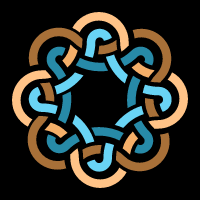I want to zoom out of the exhibition space to a city level.

A single picture or a video can’t capture an amazing experience of Museum Night in Belgrade. It’s a cultural spectacle that spans more than 120 cities around the world. In my country almost 200 locations in more than 60 cities host about 500,000 visitors.
This coordinated manifestation benefits greatly by location based audio.

HearUsHere lets you compose your own audio experiences on any location by assigning audio to a location on a map. You can walk towards the sounds or stories you want to hear, approaching them will increase volume. Sounds will overlap and crossfade from one to another while you’re traveling. You create your own personal experience by changing location and creating your own route.
The app is created for non-linear and location based storytelling which allows new narratives to arise.
Roundware is contributory audio augmented reality platform. It shares a lot of functionality with HearUsHere and improves upon it in many ways. Most impressive is the use of centralized repository that makes it possible for many people to collaborate. From that repository, a seamless, non-linear, location-sensitive layer of audio in any geographic space is mixed on the fly based on participant input.
Location based audio could help us scale coalescence to the level of the city and beyond, by coordinating exhibition spaces and bridging the space between them.
How does it all connect?
I’ll assume you’re familiar with the web platform I’m building for real-time music collaboration. In summary, my platform will create a way for musicians and artists of differing disciplines to collaborate and for audience to participate in the process of music making. Musicians associate sounds with objects in the exhibition space. Sounds are playing on a loop, and together form a coherent musical composition. Each audio loop can be customized in real-time by the visitors of the exhibition.
With the use of technology of a location based audio app like Roundware, each exhibition space will broadcast its live musical performance to the people in the area.
This is possible by the use of Geolocation API in the web browser. By opening a page on the web and allowing it to read GPS of your device it can pinpoint your location on a map in real-time.
Virtual concentric circles are drawn on a map around the location of the exhibition spaces. Broadcasted audio and its character is determined by the person’s location, specifically by the virtual circle they’re location in. Checkout proof of concept on my github.
Outer circles overlap with one another. When a person who is tuned in to the broadcast finds himself in a location where circles overlap, he hears multiple musical compositions, each emitted from its respective exhibition space. Not only is the music performed live and in multiple locations across the city in real-time but the location they’re hearing it from will affect its sound. Here we’re bridging the physical gap between locations, where sound can’t physically travel to mix together, by a device ( phone e.g. ) that’s connected to the internet.
Hearing two songs playing at the same time is usually an unpleasant experience because they’re not made as a coordinated effort. They’re usually made by people from a different period in history, culture, tempo and key. Masters of DJing, for example, mastered mixing different songs together. While performing live they find commonalities in songs and overlap them with one another to create a good sounding composite.
This musical challenge HearUsHere doesn’t address because it only crossfades between songs. I can see how these overlapping zones can be enriched by musical composites.
Overlapping zones
Can two unique songs, created on the spot, by performers from two distant locations, sound good together if performers can only hear their own performance? Sounds impossible. It calls for a compromise that’s achieved in an interesting way:
Crossfading between recorded music and live performance.
On my platform live performance is built upon recorded sounds. When a person is outside and is getting close to the overlapping zone we’re going to crossfade from a live performance to a recorded song to create a seamless transition.
We’ve avoided the impossible blending of two live performances by compromising on the live aspect. We’re left with the challenge of blending two different songs in overlapping zones. Task of composing two and more songs to fit perfectly together is difficult. To make it easier we only have to make some of their parts fit together well.
Ideally each musical composition has a signature musical motif that can fit together well with motifs of other songs. I’ll be solving this musical challenge of composing many songs that fit together in this way in an upcoming article.
Overlapping zones are as much a destination as a transitory space. They’re a unique environment to visit, so mark their location on a map and invite your friends to join.
Music hubs
Under the right circumstances, spontaneous gathering will emerge. Phones make it easy to share location with a friend and every phone comes with a speaker that can play music. On the same web page from which you’ll listen to the broadcast you’ll see a map that contains marked locations of other listeners to make it easy to spot gatherings.
Realistically, most people will gather in bars and music venues that are prepared to entertain and serve them on a big night such as the Museum Night. Places that play music will be hard to incentivise to play something other than what their clientele are used to hearing.
To compete with them, temporary stages can be set up and venues booked for the occasion.
Conclusion
Location based audio is new and exciting strategy for enhancing immersion and creating meaningful aesthetic experiences. It helps create a game everyone will want to play by scaling coalescence to a new level.
To join my private discord community and access exclusive content buy me a coffee.
